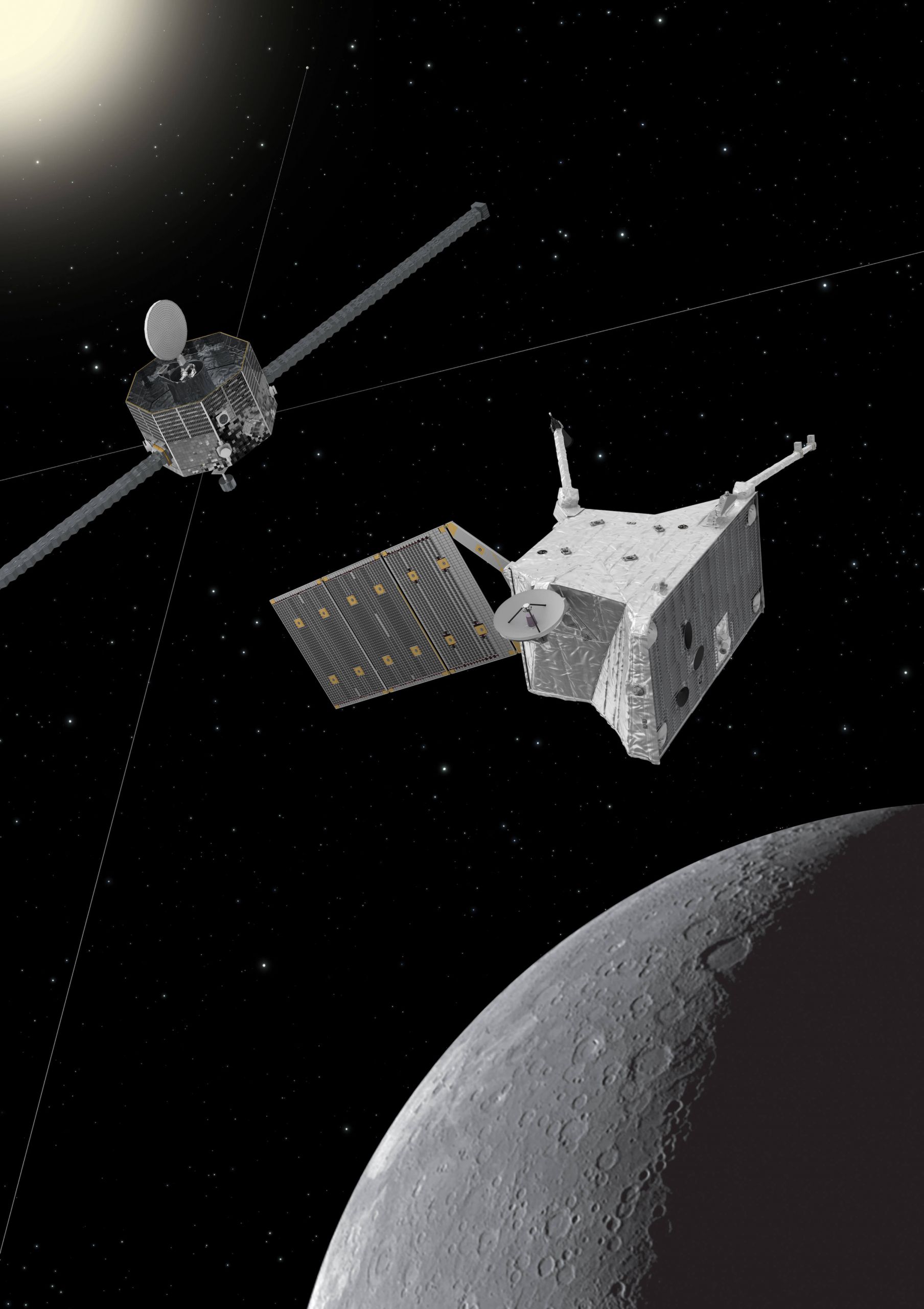PRESENTATION
The Applied Electromagnetism Group (GEA) has more than twenty years experience in developing software tools for the analysis and design of passive devices, periodic structures and antennas for space applications. The group has implemented efficient numerical methods in computational electromagnetism, based on hybridization of MoM, MEF, Modal Analysis and Domain Decomposition.
Different waveguide components have been designed, manufactured and measured (polarizers, filters, diplexers/triplexers, OMT, power combiners, beam forming networks) and dichroic subflectors. Some have been used in telecommunications satellites (Hispasat-1A-B-C-E, Artemis, Sesat, Astra-1K-3B-1M, Europe*Star, Newbird, Sky-Bridge, Eutelsat-W2A, Amazonas-2-5, among others) and in scientific missions (Mars Express, Venus, Express, Rosetta, Herschel-Planck, Bepi-Colombo).
GEA has led several ESA contracts to develop innovative reflectarray technologies for space applications, including satellite antennas with different coverages in Ku-band and for multi-beam coverage in Ka-band.
Other areas of research are: the development of antennas to electronically scan or reconfigure the beam using different technologies (pin diodes, MEMS and liquid crystals) in the frequency range from 9 GHz to 300 GHz; design of RF components based on metamaterials; and evaluation of biological effects of electromagnetic fields, including hyperthermia and dosimetry.

ABOUT GEA
GEA has its origins in 1980, when a group of professors (J.E. Page, J. Zapata, C. Camacho and J.M. Rebollar) of the E.T.S. of Telecommunication Engineers of the Universidad Politecnica de Madrid (UPM) adopt the name “Applied Electromagnetism Group”. Since its inception, GEA’s research activity has focused on the development of new methods for the analysis and design of passive and active microwave devices.
In parallel, GEA initiated a line of research focused on the biological effects of electromagnetic waves and their possible therapeutic applications (early detection and treatment of breast cancer) and agricultural (pest control by sterilizing insects with electromagnetic fields). Several projects were carried out on “Microwave Thermography for breast cancer diagnosis”, in collaboration with the Radiodiagnosis Service of the National Institute of Oncology, which carried out the clinical evaluation. This collaboration continued until 1988, conducting demonstrators and clinical tests for the treatment of cancer by microwave hyperthermia. We have also studied the possible harmful effects on the population, produced by mobile telephony, broadcasting and high voltage lines, contributing to the preparation of the Spanish regulation CTE/23/2002 for mobile phone networks.
Over the years, GEA has been specializing in the development and implementation of efficient CAD tools and analysis methods for passive devices, periodic structures and antennas in the microwave and millimeter-wave bands, with applications in communications systems, radar and space. The group has designed different components of radio frequency systems for communications satellites (Hispasat-1A-B-C-E, Artemis, Sesat, Astra-1K-3B-1M, Europe*Star, Newbird, Sky-Bridge, Eutelsat-W2A, Amazonas-2-5, among others) and for scientific missions (Rosetta, Herschel-Planck, Bepi-Colombo). We have also designed dichroic subflectors for high-gain antennas used to send images to earth in Mars Express and Venus Express missions from the ESA.
RESEARCH AREAS
Reconfigurable antennas for 5G millimeter wave networks.
Development of efficient techniques for analysis and design of RF devices and antennas.
PROJECTS WITH INDUSTRY

USA
Passive reflectarray panels are being designed to improve coverage areas in the deployment of the new millimeter-wave 5G networks.

China
A reconfigurable beam antenna was designed for high-performance base stations, by implementing liquid crystal technology in a reflectarray antenna.

DEFENSE & SPACE
Design of feed-chain for Amazonas 4B satellite and Asymmetric OMT for AMU satellite.
INTERNATIONAL COLLABORATIONS
UNIVERSITÀ DI TRENTO
A collaboration has been initiated with Professor Andrea Masa at the University of Trento for the development of design techniques for high performance reflectarray antennas. The new design procedure is base on the “System-by-design“ technique proposed by the group at University of Trento. This technique will allow numerically efficient optimization of large reflectarray antennas with complex elements and a high number of degrees of freedom.
Queen’s University of Belfast
GEA team has been collaborating more than 10 years with Professor Fusco’s research group from the “Institute of Electronics, Communications and Information Technology (ECIT) associated to Queen’s University of Belfast (QUB)” for the development of new liquid crystal-based reconfigurable beam antennas. We have designed, manufactured and tested several demonstrators in frequency bands from 10 GHz to 100 GHz for different applications, such as safe surveillance, radar or remote sensing. ECIT-QUB has capacity for manufacturing in clean room and RF measurement of devices and antennas up to 300 GHz. GEA has participated with ECIT-QUB in one ESA project and in several research projects supported by the governments of United Kingdom and Spain.
UNIVERSITY OF TORONTO
The collaboration with Prof. S. V. Hum of the University of Toronto was established in 2014 when he made a 3-month stay in Madrid and participated in the design of multi-beam reflectarray antennas in Ka band for communications satellites. This line of collaboration continued with a stay of Eduardo Martínez de Rioja in Toronto and in the joint participation in several research projects funded by the governments of Canada and Spain.
IT'IS FOUNDATION
A collaboration with IT’IS (Foundation for Research on Information Technologies in Society, IT’IS) Zürich, Switzerland, is mantained on different studies about the specific absorption rate (SAR), which is a measure of the rate at which energy is absorbed per unit mass by a human body when exposed to an electromagnetic field. The results of these studies have been used in the planning of hyperthermia treatments, using microwaves, in the ISM band (specifically 433.92 MHz) as a heating medium. Derived from this work, a close collaboration is also maintained with Prof. Quirino Balzano (IT’IS Foundation and the University of Maryland) on the assessment of exposure of portable wireless devices at frequencies above 6 GHz, with application in the new 5G technology.
UC DAVIS
This is a collaboration with the group led by Prof. Juan Sebastian Gomez-Diaz from the University of California in Davis, for the developing of non-reciprocal antennas, antennas with different radiation characteristics in transmission and reception. This collaboration has resulted in different publications in both conferences and journals.
QUEEN'S UNIVERSITY KINGSTON, CANADA
As a result of a sabbatical stay made by Prof. Carlos R. Escobedo from Queen’s University in Kingston (Canada), a research line has begun on different topics related to microfluidics. On the one hand, in the development of reconfigurable antennas using non-toxic liquid metal (Galinstan), and on the other hand, in lines related to hyperthermia, studying the possibility of using certain type of microorganisms (magnetostatic bacteria) that can be guided by magnetic fields using capillaries, and that could eventually be used to heat a fluid.
EMBRY-RIDDLE
A collaboration is maintained with the laboratory led by Prof. Eduardo Rojas, focused on the development of antennas which are fabricated using additive manufacturing techniques.
COLORADO STATE UNIVERSITY
Collaboration with the Department of Electrical and Computing Engineering at the University of Colorado in USA, and in particular with Professor Branislav Notaros, to collaborate in research work and projects related to the analysis and design of antennas and radiating structures. Professor José Ma Gil made a stay in this department during the last quarter of 2009.
MCGILL
Collaboration with Professor J. P. Webb in the Electrical Engineering Department of McGill University in Montreal, Canada. The topic of collaboration was the development of new high-order vector finite elements. This relationship began in 1995 and since then the professor of the research group José. M ª. Gil has made two stays of 6 months in this Department.
UNIVERSITÉ CATHOLIQUE DE LOUVAIN
Collaboration in the development of antenna synthesis algorithms with Professor C. Craeye of the Institute for Information and Communication Technologies, Electronics and Applied Mathematics (ICTEAM) of the Université Catholique de Louvain, Louvain-la-Neuve, Belgium.
University of Birminhan
In 2011 we initiate a collaboration with the Research Group led by Prof. Michael Lancaster at the University of Birmingham’s for the design of passive waveguide devices manufactured by micro-machining techniques. This collaboration began with a research stay by Carlos A. Leal Sevillano. In addition, the stay in the United Kingdom allowed contact with other groups, such as with the Jodrell Bank Center of the University of Manchester. We developed in collaboration with Dr Giampaolo Pisano very low loss filters for radio astronomy.
Jet Propulsion Laboratory
In 2012 Carlos A. Leal Sevillano initiated fruitful collaboration during a research stay at NASA Jet Propulsion Laboratory, California Institute of Technology, for the development of several devices for future space missions in the submilimetric waveband. Among others, we have developed several devices that currently constitute the state of art in these bands such as: duplexers (including horn antennas and polarizers) for image compact radars, OMTs for earth observation instruments and filters implemented by DRIE technology up to 700GHz.




